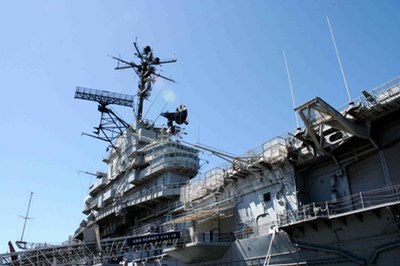The Grey Ghost, fadingby Dwayne A. Day
|
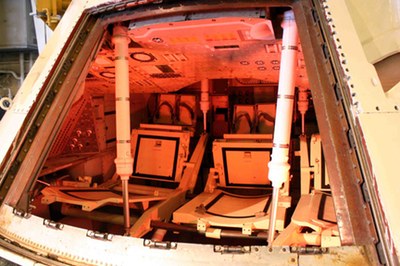 Interior of an Apollo Command Module boilerplate. (credit: D. Day) |
Instead, the Apollo 11 recovery effort went off without a hitch and the USS Hornet added another entry into her lengthy and impressive logbook. A few months later she did it again with the crew of Apollo 12. And not much later than that the ship was decommissioned, then mothballed. There was never any chance that she would reenter service after that. The Essex-class carriers—Hornet was the fourth—had been built during the Second World War and by the late 1960s they were all worn out. Worse, most of them, like Hornet, could no longer handle the Navy’s mainline jets and it was clear that even if they were modernized they would not be able to handle the new aircraft then in development, like the very heavy F-14 Tomcat. Hornet was really only placed in reserve to provide spare parts to the few other Essex-class ships that were being kept around a little longer, and until the Navy bureaucracy, which moved about as fast as molasses on Pluto, could sign a contract to scrap her.
Twenty years later, after all but a handful of her sisters had gone to the breakers, Hornet was designated a museum ship and towed to Alameda Naval Air Station, across the bay from San Francisco. Alameda closed soon after and quickly fell into decay, but the Hornet is still there, sitting quietly at a pier.
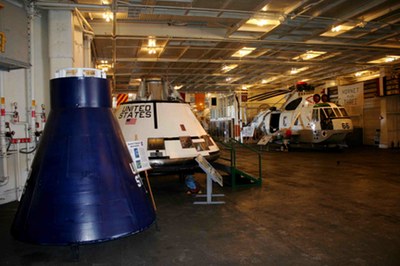 Space artifacts aboard the Hornet’s hangar deck. The helicopter appeared in the movie Apollo 13. (credit: D. Day) |
Her exterior needs work. Paint is peeling on her exposed surfaces and her flight deck needs resurfacing and painting. Only her curators know the status of her hull. Ships leak, especially old ones. They require pumps and attention to keep their lower decks from filling with water. At some point Hornet will have to be towed to a drydock and her hull repaired.
But the areas of the Hornet that are publicly accessible are in good condition. Visitors can walk her hangar deck and see the helicopters representing every helo that ever recovered an astronaut at sea. They can see a Gemini capsule mockup and an Apollo Command Module boilerplate. They can go into her admittedly sparse Apollo exhibit. They can go below the hangar deck and visit the sick bay and the mess decks and the crew quarters and the chapel. They can also wander through the numerous sections devoted to all of the Essex-class carriers. They can also take escorted tours of her island and, by special request, the admiral’s quarters and the catapults. If they do, they will probably encounter few other people. Hornet’s nickname was “the Grey Ghost,” and often she feels like a ghost ship. Indeed, she is reputed to be haunted, something that the curators clearly play up for the publicity.
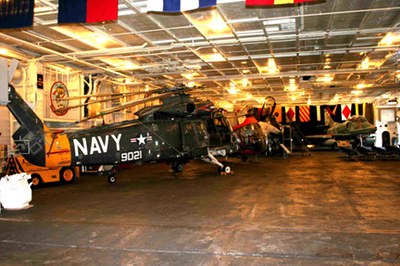 Several helicopters aboard the museum ship are painted to represent helicopters used to recover American astronauts. (credit: D. Day) |
Alameda is not exactly a garden spot of California. It used to be the site of a vast naval base. Now it’s really a run-down industrial area on the edge of a vast container port. The base’s huge airfield has overgrown with weeds and serves only as a site for Mythbusters episodes that require somebody to smash a car into a wall. The base’s housing has been torn down and gradually replaced with condos. Its big warehouses and hangars have either been abandoned or rented out for industrial storage or gyms. Its piers have been taken over by the Maritime Administration’s fleet, where a bunch of old, but serviceable freighters are moored. USS Hornet is there, at Pier 3. Very few people visit.
Recently, retired Lieutenant Commander Thomas J. Cutler wrote in an article for Naval History magazine that the biggest factor affecting the success or failure of a museum ship is location. The USS Midway, a larger carrier that entered service only a few years after Hornet but too late for the war and too late to win the battle scars that Hornet did, is located at a prime spot in San Diego and is wildly successful. She attracts many tourists as well as lucrative business parties. Midway is so popular that it’s a shame there are no other retired warships to bask in her attention. New York City has one of Hornet’s sisters, the USS Intrepid, which is also quite popular. Honolulu has the battleship USS Missouri. But the United States has a lot of retired warships serving as museums and many of them are barely surviving. As Cutler noted, location is everything, and Hornet’s location is awful.
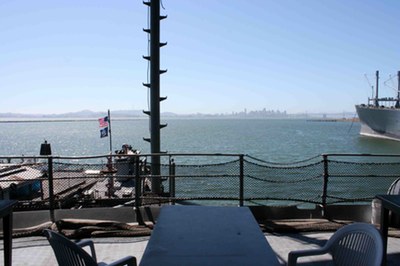 San Francisco, as seen from the ship’s stern. (credit: D. Day) |
If you stand on Hornet’s stern you can look across the bay and see San Francisco. San Francisco used to be a Navy town. The bay used to be ringed by shipyards and naval facilities. Things have changed since then. (Politics have changed too.) The Hornet belongs not in Alameda, but across the bay, in San Francisco. Her role as the Apollo recovery ship deserves greater attention and more people. And if she was moored closer to a major population center she could benefit from the business parties that help bring in the money needed to keep her afloat and able to tell the story of Apollo.
She survived the Moon germs. Now she needs to survive the rust.
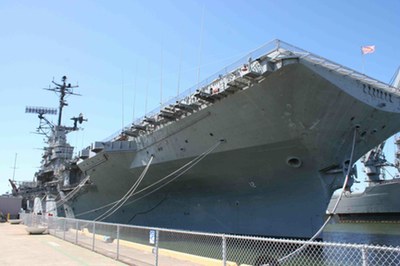 USS Hornet Museum at Alameda, California. (credit: D. Day) |
